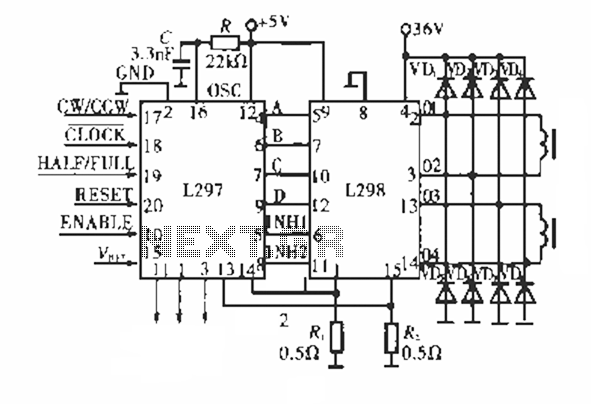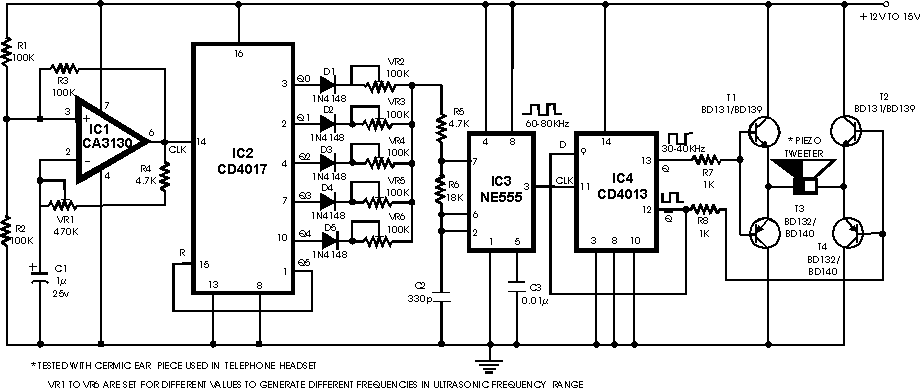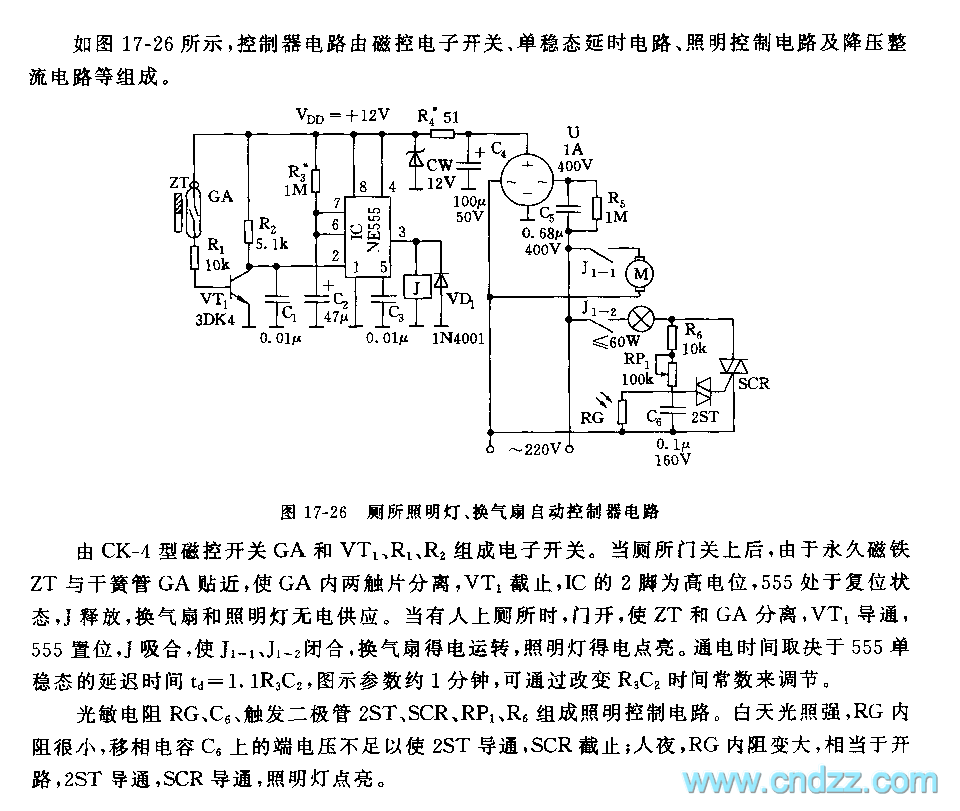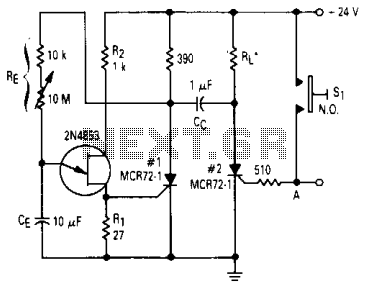
Bipolar stepper motor driver module circuit

The circuit operates using a dedicated stepping motor controller, the L297. Pin 17 (CW/CCW) is utilized to control the rotation direction of the stepper motor. Pin 18 (CLOCK) regulates the speed of the stepper motor, while pin 19 (HALF/FULL) allows for the selection between full-step and half-step operation. Pin 20 (RESET) is set low to return to the initial state upon power restoration, with the output configuration ABCD = 0101. Pin 10 (ENABLE) functions as the chip reset terminal; when low, it sets ABCD = 0000, ensuring that each phase of the stepper motor remains de-energized for manual adjustments. Pin 15 (VREF) serves as the reference voltage terminal, determining the current through the stepper motor coils, with Vref defined as Rs1 (Rs2), typically with Rs1 and Rs2 equal to 0.5 Ohm. Pin 16 (OSC) requires an external RC network that influences the chopping frequency of the chopper circuit, calculated as f = I / (0.7RC), where R must exceed 10 kΩ. A typical chopping frequency of 20 kHz is illustrated. This circuit is designed to drive a stepper motor with a rated voltage of 36 V and a current of 2 A across all four lines, accommodating both permanent magnet and hybrid stepping motors with six leads.
The L297 stepping motor controller is an integrated circuit designed to facilitate the control of stepping motors, allowing precise operation in various applications. The controller is capable of handling both full-step and half-step driving modes, which can optimize torque and resolution based on the application's requirements. The CW/CCW pin configuration enables straightforward direction control, making it suitable for applications requiring bidirectional movement.
The CLOCK input is essential for speed regulation; by adjusting the frequency of the clock signal, the user can control the step rate of the motor, which directly influences the speed. The RESET functionality ensures that the system can return to a known state after power interruptions, which is critical for maintaining operational integrity in automated systems.
The ENABLE pin serves an important role in power management, allowing the motor phases to be disabled when not in use, thus conserving energy and preventing overheating. The reference voltage at VREF is crucial for setting the current through the motor coils, which affects the motor's performance characteristics such as torque and responsiveness.
The OSC pin's external RC network is vital for determining the chopping frequency of the drive circuit, which is essential for efficient operation of the stepping motor. The choice of resistor and capacitor values directly impacts the performance, and the specified minimum resistance helps prevent excessive current draw, ensuring safe operation.
Overall, the L297 controller provides a robust solution for driving stepping motors, offering flexibility in speed, direction, and operational modes, making it an excellent choice for various applications in robotics, CNC machinery, and precision positioning systems.Circuit works: Figure shows a dedicated stepping motor controller L297 key pin, 17 feet (cw / ccw) is used to control the stepper motor rotation direction 18 feet (CLOCK) used to control the speed of the stepping motor speed ; 19 feet (HALF / FULL) for stepper motor full-step, half-step selection; 20 feet (rESET) is low, to the initial state when power is restored, ABCD = 0101; 10 feet (ENABLE) for the chip reset terminal when the terminal is low, ABCD = 0000, that is, each phase stepping motor is not energized in the workplace in order to manually adjust some tuning work location; 15 feet (VREF) as a reference voltage terminal of the voltage determines the step electric motive coil current is, Vvef = is Rs1 (Rs2), general Rs1 - Rs2 - 0.5 Omega; 16 feet (Osc) external RC value depends on the frequency of the chopping frequency of the chopper circuit is f = I / ( 0. 7R C), R must be greater than 10 k , 20 kHz shown in the figure is typical chopping frequency. Use this line to drive the following rated voltage 36 V, 2 A similar within all four lines, six lines of permanent magnet or hybrid stepping motor.
The L297 stepping motor controller is an integrated circuit designed to facilitate the control of stepping motors, allowing precise operation in various applications. The controller is capable of handling both full-step and half-step driving modes, which can optimize torque and resolution based on the application's requirements. The CW/CCW pin configuration enables straightforward direction control, making it suitable for applications requiring bidirectional movement.
The CLOCK input is essential for speed regulation; by adjusting the frequency of the clock signal, the user can control the step rate of the motor, which directly influences the speed. The RESET functionality ensures that the system can return to a known state after power interruptions, which is critical for maintaining operational integrity in automated systems.
The ENABLE pin serves an important role in power management, allowing the motor phases to be disabled when not in use, thus conserving energy and preventing overheating. The reference voltage at VREF is crucial for setting the current through the motor coils, which affects the motor's performance characteristics such as torque and responsiveness.
The OSC pin's external RC network is vital for determining the chopping frequency of the drive circuit, which is essential for efficient operation of the stepping motor. The choice of resistor and capacitor values directly impacts the performance, and the specified minimum resistance helps prevent excessive current draw, ensuring safe operation.
Overall, the L297 controller provides a robust solution for driving stepping motors, offering flexibility in speed, direction, and operational modes, making it an excellent choice for various applications in robotics, CNC machinery, and precision positioning systems.Circuit works: Figure shows a dedicated stepping motor controller L297 key pin, 17 feet (cw / ccw) is used to control the stepper motor rotation direction 18 feet (CLOCK) used to control the speed of the stepping motor speed ; 19 feet (HALF / FULL) for stepper motor full-step, half-step selection; 20 feet (rESET) is low, to the initial state when power is restored, ABCD = 0101; 10 feet (ENABLE) for the chip reset terminal when the terminal is low, ABCD = 0000, that is, each phase stepping motor is not energized in the workplace in order to manually adjust some tuning work location; 15 feet (VREF) as a reference voltage terminal of the voltage determines the step electric motive coil current is, Vvef = is Rs1 (Rs2), general Rs1 - Rs2 - 0.5 Omega; 16 feet (Osc) external RC value depends on the frequency of the chopping frequency of the chopper circuit is f = I / ( 0. 7R C), R must be greater than 10 k , 20 kHz shown in the figure is typical chopping frequency. Use this line to drive the following rated voltage 36 V, 2 A similar within all four lines, six lines of permanent magnet or hybrid stepping motor.
Warning: include(partials/cookie-banner.php): Failed to open stream: Permission denied in /var/www/html/nextgr/view-circuit.php on line 713
Warning: include(): Failed opening 'partials/cookie-banner.php' for inclusion (include_path='.:/usr/share/php') in /var/www/html/nextgr/view-circuit.php on line 713





